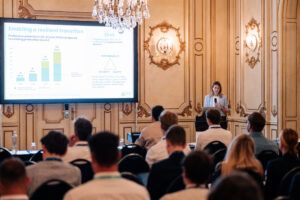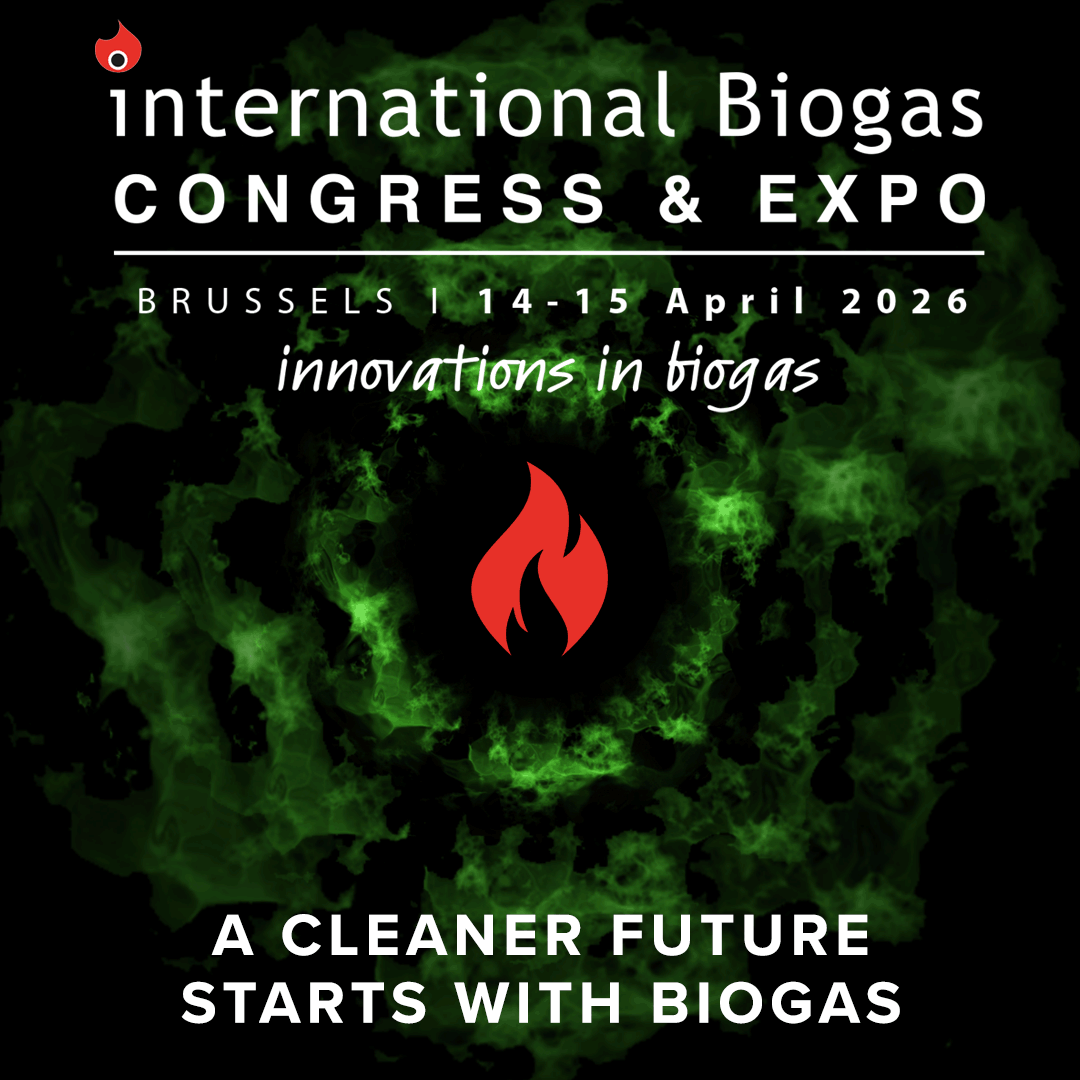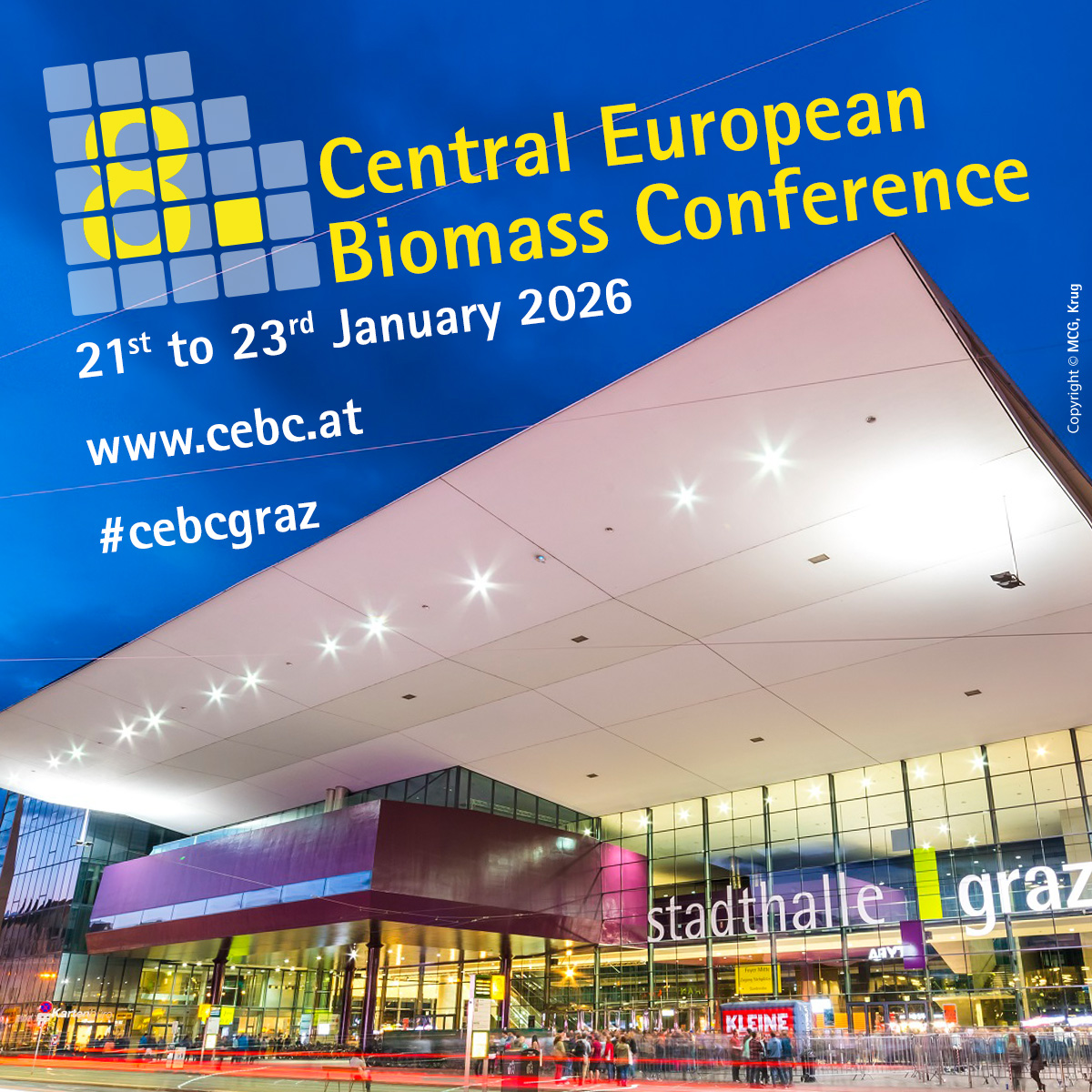Attracting sector investment was a key theme at International Biogas Congress and Expo

This year's conference focused on the pivotal role of biogas in achieving decarbonisation, energy security and net-zero targets. Discussions centred around the European Union's Fit-for-55 package, the REPower plan and how these initiatives can benefit the biogas sector. High-level speakers addressed topics including biomethane market updates, policy developments and technological advancements .
The event also highlighted the growing investment in the European biomethane sector, with projections estimating €25 billion in private investments by 2030. Attendees had the opportunity to engage in networking sessions, explore exhibition booths and participate in discussions that bridged the gap between science and practice.
Co-located with the Sustainable Aviation Fuel Summit and the Biofuels International Conference & Expo, the 2025 International Biogas Congress & Expo provided a comprehensive platform for stakeholders to collaborate and drive the future of biogas forward.
This report delves into the key takeaways from the conference, examining the latest trends, challenges and opportunities within the biogas industry.
Policy momentum and market growth
Grazia Vascello, policy officer at the European Biogas Association (EBA), offered a comprehensive overview of the policy developments and market trajectory shaping Europe’s biogas and biomethane sectors. Representing more than 50 national associations and research bodies, the EBA plays a central role in promoting the interests of the bioenergy industry within EU institutions.
Vascello outlined four key policy priorities. First, the European Commission's strategic agenda continues to emphasise energy security and competitiveness, positioning biomethane as a core solution to reducing dependence on Russian gas.
Second, RePowerEU and the revised Renewable Energy Directive (RED III) are accelerating legislative support for renewable gases, mandating national plans to boost alternatives like biogas.
Third, the 2040 climate targets will shape emissions trajectories and influence future updates to EU energy legislation.
Lastly, she emphasised the importance of the EU Forest Strategy and emerging carbon capture pathways, where biogas can offer unique contributions.
Market growth is robust. In 2023, biomethane production approached 5 billion cubic metres – a remarkable 80% year-on-year increase – with leading contributions from France, Denmark and the UK.
The EU now hosts more than 1,300 operational plants, 85% of which are grid-connected. Newer facilities are increasingly using sustainable feedstocks such as agricultural residues and waste, rather than energy crops.
Investment momentum is also strong. In 2023, €2.7 billion was invested in the sector, with 150 additional plants expected to come online over the next five years. Countries like Ireland, Spain, Portugal and Poland are emerging as attractive markets for new development.
Biogas in the Arctic
Simon Ford, director of technical development at Rå Biopark, delivered an insightful presentation on the challenges and breakthroughs of building biogas infrastructure in Northern Norway – one of Europe’s most remote and logistically complex regions.
Drawing on his experience leading a multi-municipal initiative in Troms and Finnmark, Ford explained how strategic collaboration is transforming fragmented organic waste into a reliable, renewable energy source.
Historically, the region lacked both the scale and infrastructure to support viable biogas production. However, by coordinating public-sector waste operators across a territory larger than Belgium, Rå Biopark consolidated 15,000 tonnes of household organic waste, supplemented by input from breweries, agriculture, and Norway’s expanding aquaculture industry. The latter is shifting northward, creating new opportunities – and pressures – for sustainable waste management.
With no gas grid in place, the project is focusing on biomethane for transport. Thanks to high diesel prices and favourable tax treatment, renewable gas is an increasingly attractive alternative. The Norwegian government is co-financing three to four new fuelling stations to support heavy goods vehicle adoption.
Digestate management, a common challenge in remote areas, is being tackled through evaporation towers and wet pyrolysis, producing condensed, transportable outputs such as ammonia for industrial use. A new site – co-located with a waste incineration facility – will enable heat integration and improve logistical efficiency.
Ford underlined that this success would not have been possible without public-private cooperation, technical adaptability, and long-term commitment. What began as a scattered, low-volume waste system is now a scalable circular economy model for rural and Arctic regions – delivering climate benefits, local value and enhanced energy security in an area where few had imagined it could succeed.
Trading in Europe
Lucas Oliveira, from Engie’s Global Energy Management biomethane trading desk, gave a detailed account of the operational and regulatory complexity behind scaling up Europe’s biomethane trade.
Speaking on behalf of one of Europe’s largest gas trading companies, Oliveira stressed Engie’s ambition to reach 10 TWh of biomethane production by 2030, backed by €3 billion in investment.
With over 500 contracts with small producers in France alone, and trading activity spanning nine countries, Engie faces immense logistical and data management challenges in handling guarantees of origin (GOs), proof of sustainability (PoS) and gas molecules.
Oliveira underscored the fragmented nature of the European biomethane market. Registry systems, accepted feedstocks, certification schemes, units of measurement and data formats all vary from country to country. These discrepancies make cross-border trading technically difficult and administratively burdensome.
As a trader, Engie must reconcile the different requirements of voluntary and national sustainability schemes, convert units (such as heating values at varying temperatures) and match supply to diverse client demands – whether for waste-derived gas, RED II compliance, or specific PoS criteria.
To cope, Engie developed an internal digital tool named METAPoS. It tracks deliveries, automates data transposition between certification schemes (e.g. 2BSvs and ISCC), manages inventory and generates audit-ready mass balance reports.
Oliveira described how this tool helps ensure compliance, avoid double counting and unlock market value – particularly important given the increasing scale and complexity of their portfolio.
Looking ahead, Oliveira highlighted the need for harmonisation at EU level, not only to streamline administrative burden and reduce manual errors, but to open up cross-border market liquidity. He noted that pending legislation under the Union Database for gaseous fuels (UDB) may help standardise data flows. Until then, large players like Engie are building their own digital infrastructure to make sense of a highly heterogeneous market.
Nordic know-how
Ari Suomilammi, head of renewable gases at Gasum, offered an in-depth look into the challenges and opportunities of biomethane sourcing and trading in the Nordic region.
With extensive experience spanning nearly eight years in biomethane production and decades managing gas permissions, Suomilammi outlined Gasum’s integrated role in Finland, Sweden and Norway’s gas ecosystem.
As a state-owned company, Gasum delivers natural gas primarily in liquid form alongside biomethane and provides energy market services including power management. Its ecosystem encompasses biogas production support for agriculture, multiple import terminals for liquid biomethane, a network of about 20 biogas plants, and over 100 gas filling stations.
Suomilammi emphasised the rising demand for biomethane, particularly in the transport sector, driven by a combination of domestic production and imports from across Europe.
Gasum structures long-term sourcing contracts, often up to ten years, blending biomethane with grey gas in a “bio premium” model that balances sustainability with market realities. Emerging areas like biomethane from waste and bio-based CO2 are being explored, though volumes remain modest.
A key point was the complexity of operating within fragmented regulations and a lack of standardised markets. Biomethane premiums vary by country and registry, and unlike traditional commodities, biomethane trading faces challenges in pricing transparency, risk management and accounting.
Suomilammi identified major risks as market exposure through open positions, counterpart risk in long-term agreements, and regulatory uncertainty, which can abruptly impact sourcing and sales.
Gasum manages these risks through fixed-price sourcing contracts and hedging the grey gas component, while carefully controlling open positions based on company strength.
Logistics also present challenges, with delivery involving injection into gas grids, liquefaction and shipping where pipeline networks are limited. Suomilammi concluded that while the European biomethane market remains nascent and complex, demand growth, especially in transportation, underscores the need for regulatory harmonisation to unlock its full potential.
Certifying biomethane
Tim Hamers, secretary general of the European Renewable Gas Registry (ERGaR), spoke about the current challenges and opportunities in certifying and trading biomethane and biogenic carbon dioxide (bio-CO2) across Europe.
He highlighted the fragmented certification landscape that currently exists, with different frameworks depending on the gas’s source and end use – such as carbon removal, renewable energy directives or voluntary markets – which complicates cross-border trade and risks double counting.
Hamers stressed that certification is a key part of the solution to unlocking the market for bio-CO2 and biomethane, gases produced from biogas plants and bio-refineries with diverse applications ranging from beverage carbonation to fuels and greenhouse use. The complexity increases due to multiple use cases and varying certification requirements, often resulting in additional administrative burden without added benefit.
ERGaR advocates for a harmonised, single certification system that would streamline processes, prevent double counting and provide clarity and trust for producers, buyers and regulators. He explained ongoing efforts to connect Guarantees of Origin registries with the European Union’s central database, aiming to improve transparency and ease market operations.
Hamers also discussed regulatory developments, including incentives and certification rules for aviation fuels and the importance of upcoming delegated acts expected to clarify these frameworks. He emphasised the importance of harmonisation and registry integration as critical steps towards enabling a more efficient and credible market for renewable gases in Europe.
Optimising carbon intensity
Roland Kok, founder of Route to Market, highlighted that many biogas producers make avoidable mistakes during on-site biogas or biomethane production, but these can be transformed into valuable optimisations.
A key area is the use of disaggregated feedstock meeting regulatory standards (MERs), including dry or processed manures such as chicken manure or thick fractions of cattle manure. Optimising transport values – especially for feedstock with low dry matter content – can significantly improve efficiency and carbon intensity. Properly aggregating and using actual measured values of feedstock quality often yields better results than default values.
Kok pointed out that emissions estimates from biogas processing and upgrading are often overly conservative. By using actual methane emission measurements, producers can lower carbon intensity and increase compliance benefits.
Additionally, biogas production bonuses – around 25 cubic metres of biogas per tonne of manure – can be claimed if yields exceed this benchmark.
Interestingly, sourcing feedstock from farther distances is allowed when regulations are followed and auditors informed, offering strategic flexibility. Stable feedstock supply is essential for investor confidence, and thoughtful feedstock allocation can optimise carbon scores.
Administrative optimisations include reducing methane leaks, applying lower emission factors where justified and improving transport fuels like HVO. Increasing dry matter content or capturing C2 gases can improve carbon intensity but may increase operational costs.
Kok also stressed careful management of CO2 capture credits, as environmental attributes cannot be double-counted. Overall, he noted that optimising carbon intensity goes beyond regulatory compliance – it’s a strategic imperative to create value and competitiveness in evolving carbon markets. Producers must engage smartly with carbon intensity metrics to thrive in future biogas sectors.
The growing role of private equity
Khash Mohajerani, co-founder and partner at OrbeNovo Capital, outlined the appeal and challenges of private equity investment in the biogas sector, particularly across Western Europe. OrbeNovo specialises in energy investments and currently manages an £80 million capital investment in the UK biogas platform EAG Bio Energy.
Mohajerani highlighted biogas as a compelling sector due to its unique ability to provide modular, clean energy that complements intermittent renewables like wind and solar. He pointed out the strong EU policy support targeting a 10-fold increase in biogas production by 2030, alongside a focus on domestic energy security – advantages that attract private equity interest.
The sector is evolving from a fragmented landscape of small, farm-based operations to larger, professionalised platforms that can deliver scalable, cash-generative businesses. Private equity firms prioritise investing in experienced management teams with proven track records, favouring platform-building over one-off asset purchases.
Feedstock price stability and a clear regulatory environment are vital, though Mohajerani warned about the practical limits of long-term feedstock contracts with farmers.
Business models vary from lower-risk acquisitions of operating assets – yielding 11-14% returns – to greenfield development projects with higher capital but similar returns. The sector’s complexity, including risks around feedstock, operational efficiency and permitting delays, demands careful risk mitigation.
EAG Bio Energy exemplifies value creation through strategic acquisitions and converting biogas electricity plants into higher value biomethane facilities, benefiting from attractive market prices. Ancillary revenues from heat, digestate and CO₂ represent additional growth opportunities.
Looking ahead, Mohajerani said he expects accelerated consolidation and industrialisation of the biogas industry, alongside increased corporate partnerships. He highlighted the need for long-term policy certainty and streamlined permitting processes to attract the estimated $80-100 billion capital investment necessary to meet Europe’s ambitious 2030 targets.
ST1BioKraft’s market navigation
Miika Johansson, CEO of St1Biokraft, shared insights into the company’s ambitious growth and operational strategy in the bio-based energy sector. St1Biokraft is currently navigating a challenging supply-demand balance, selling over twice its own production volume by sourcing biomass from various suppliers, including local creek feedstocks. This dynamic evidences the importance of robust supply chain management and quality control across multiple production sites.
Johansson explained the company’s infrastructure expansion plans, with 11 new biorefinery stations opening this year and a target to establish a wide network across Sweden and Norway by 2028. These developments will significantly boost production capacity and support sustainability goals.
St1Biokraft’s dedicated R&D function focuses on maximising asset uptime and optimising substrate efficiency, ensuring the company extracts the highest value from its bio-based inputs. Additionally, the company’s strong in-house engineering team manages EPC contracts and applies industry best practices to its growing portfolio of operational facilities.
Johansson also addressed current market challenges, notably the tight contractor market with high demand and limited availability, which underscores the company’s risk management strategy of diversifying supplier partnerships.
A key investment milestone is the imminent launch of a biogas production facility in Balar, Sweden, specialising in manure processing. This project, partly owned by local farmers, reflects St1Biokraft’s commitment to community collaboration and sustainable bioenergy production.
Since its establishment in late 2024, St1Biokraft is positioned for rapid growth and actively seeks collaboration opportunities to achieve its ambitious production and sales targets in the evolving bioenergy market.
Market evolution
Sven Goethals, commercial director at Tractebel Engie, provided a comprehensive overview of the evolving biogas sector and Tractebel’s role in supporting energy transition projects worldwide.
Tractebel Engie operates across 40 countries with a workforce of 5,000 engineers specialising in complex gas and biogas engineering solutions. The company focuses on sustainability and integrated approaches to energy systems, combining technical expertise with innovative project delivery.
Goethals highlighted the market evolution from small-scale, farm-based biogas projects to larger, industrial ecosystems involving multiple stakeholders. This shift reflects a maturing sector focused on scalability and efficiency. He noted that the biogas market still experiences steady growth driven by European climate targets aiming to reduce greenhouse gas emissions by 50-55% by 2030 and increase renewable energy use to 42%.
Subsidies and regulatory frameworks vary across countries, impacting project viability. Goethals used France as a detailed case study, illustrating strong growth supported by national targets of 44 TWh biogas production by 2030.
He credited the introduction of biogas injection rights into gas networks since 2018 as a major catalyst. The French market is still largely farmer-driven, although industrial players are growing in influence. Regional development and rural revitalisation remain key priorities.
Challenges include seasonal demand fluctuations, grid capacity limitations and the need for coordinated investments between producers and grid operators. Goethals expressed the importance of guaranteed grid connection, supportive policy frameworks and evolving market mechanisms such as power purchase agreements to sustain growth.
Tractebel Engie remains confident in biogas’s role in Europe’s energy transition and its commitment to supporting the sector’s technical and commercial development across diverse markets.Top of Form
Prodeval’s pivotal role
Jean-René Pouzin, international business manager at Prodeval, delivered an engaging presentation on the company’s pivotal role in advancing biogas upgrading and biomethane injection technologies, with a strong focus on the French market.
Prodeval, a French-headquartered firm with over 400 employees worldwide, specialises in converting biogas into biomethane through innovative membrane and PSA technologies. Its equipment currently supports around 80% of France’s biomethane grid injection, with more than 600 units installed across Europe and growing international presence.
Jean-René detailed the rapid expansion of the biomethane sector over the last decade, highlighting Prodeval’s leadership in developing flexible, modular solutions to meet the diverse needs of the market.
The company’s modular approach allows for scalable, efficient plant designs that can be quickly adapted and deployed, with typical installation times reduced to around 20 weeks.
This agility positions Prodeval well to support the large number of projects underway, especially as existing Combined Heat and Power (CHP) plants transition to biomethane production.
Emphasising the company’s strategic focus, Jean-René outlined key growth regions including Italy, Spain, Eastern Europe and emerging markets such as Brazil, Poland and Ukraine. He also addressed the importance of ensuring grid connectivity, noting that nearly 90% of French biomethane projects are within close proximity to gas infrastructure, facilitating easier integration.
Beyond technology, Jean-René stressed the importance of long-term operational reliability and maintenance services, as Prodeval supports clients with contracts spanning up to 20 years. He concluded by discussing regulatory challenges and the need for clear policies to sustain bioenergy’s growth, while answering audience questions on technical and market issues.Bottom of Form
Global biogas market
Johanna Diederichs, sales trader and consultant at Green Steps, delivered a detailed presentation on the global biogas market, focusing on production, demand drivers and policy impacts across key regions.
Diederichs highlighted that Europe leads global biogas production, accounting for about 50%, with significant contributions also coming from the US, China and Brazil. Currently, approximately 45% of biogas is used in the transport sector, which is the main driver of demand worldwide.
In the US, half of biogas is upgraded to biomethane, mainly sourced from landfill gas. Early introduction of certification schemes and supportive legislation helped establish a strong market. California is aiming for full electrification of the transport sector by 2035, reserving biomethane for heavy industry applications.
China’s biogas market differs markedly, with a historically high share of raw biogas from household digesters, now shifting toward industrial production with ambitious expansion goals.
Brazil, leveraging its large ethanol industry, is expanding biomethane production by using ethanol by-products, supported by recent blending mandates.
India, although a smaller player now, shows huge potential due to its pollution challenges and policy incentives targeting a sevenfold production increase by 2035.
Europe is experiencing rapid growth in biomethane, doubling production from 6 to 12 BCM between 2023 and 2024. Diederichs emphasised that new European plants are increasingly residue- and waste-based rather than reliant on energy crops, reflecting environmental priorities.
Complex policy frameworks combining supply-side incentives and demand-side obligations are driving this growth, with EU-wide regulations like the Renewable Energy Directive and EU ETS playing major roles.
Diederichs also noted recent regulatory shifts, such as Germany’s plan to end double counting of waste-based biomethane, which immediately affected market dynamics. She stressed the importance of active policy engagement to sustain industry growth.
The presentation concluded with an outlook on the vital role of biomethane in decarbonisation and the strong influence of evolving policies worldwide.
The maritime market
Tatiana Shakhova, originator biomethane and BioLNG at Varo Energy, spoke about biomethane supply pathways and their significance for the maritime fuel market. With extensive experience in biomethane trading and storage, Shakhova highlighted Varo Energy’s strong presence in downstream distribution across Europe, including terminals in the Benelux, Germany, France and Switzerland.
Shakhova outlined three primary biomethane production pathways: on-site physical liquefaction, grid injection followed by terminal liquefaction and the innovative virtual terminal liquefaction.
The first two methods face constraints in storage capacity and scale, limiting economic viability. Virtual liquefaction, however, offers greater scale and flexibility by reversing gas flows from the grid back into LNG terminals, leveraging existing infrastructure for maritime biofuel supply.
Varo Energy’s biomethane production plant currently generates 400 GWh annually, with expansion plans targeting 650 GWh. Shakhova outlined the growing maritime demand driven by stringent emissions regulations and the economic competitiveness of biomethane relative to alternatives such as hydrogen or ammonia.
Biomethane reduces greenhouse gas emissions by up to 60% compared to conventional LNG and aligns well with upcoming FuelEU Maritime regulations.
Despite rapid market growth, supply limitations persist. Shakhova pointed out that European biomethane liquefaction capacity is insufficient to meet future maritime demand fully, highlighting the necessity for additional terminal capacity. She concluded that biomethane is a promising, scalable decarbonisation fuel for shipping, with diverse production and supply pathways tailored to different market needs and operational challenges.
Attracting funding in the biogas sector
Christian Cuenot, independent consultant at Blue Biogas, examined how to secure funding for biogas projects amid a challenging market environment. Drawing on his extensive expertise, Cuenot outlined practical strategies and key considerations for developers aiming to attract investment in 2024 and beyond.
Cuenot emphasised the importance of a well-structured approach involving six critical steps: developing a robust business case, understanding investor profiles, ensuring technical feasibility, navigating permitting processes, building strong partnerships and delivering compelling pitches. He stressed that demonstrating clear project profitability and transparently managing risks are essential to meet investor expectations.
He noted that, although the biogas sector faces pressures such as market volatility and regulatory shifts, it remains a compelling opportunity due to its competitive costs and significant carbon reduction potential. Cuenot highlighted support from organisations like the International Energy Agency, which underscores the sector’s long-term growth prospects despite short-term challenges.
The presentation categorised investors into impact investors seeking higher-risk, higher-return projects; development banks focused on strategic sustainability goals; and private equity or infrastructure funds preferring stable, lower-risk investments. Understanding these distinct investor motivations helps tailor project proposals effectively.
Cuenot also discussed common risks at various project stages, including feasibility, public acceptance, construction and operation, advising developers to engage stakeholders proactively and secure stable revenue streams through mechanisms like subsidies and long-term contracts.
Concluding, Cuenot urged biogas developers to adopt comprehensive risk management and strategic planning to enhance project attractiveness and successfully secure funding in a competitive landscape.
















